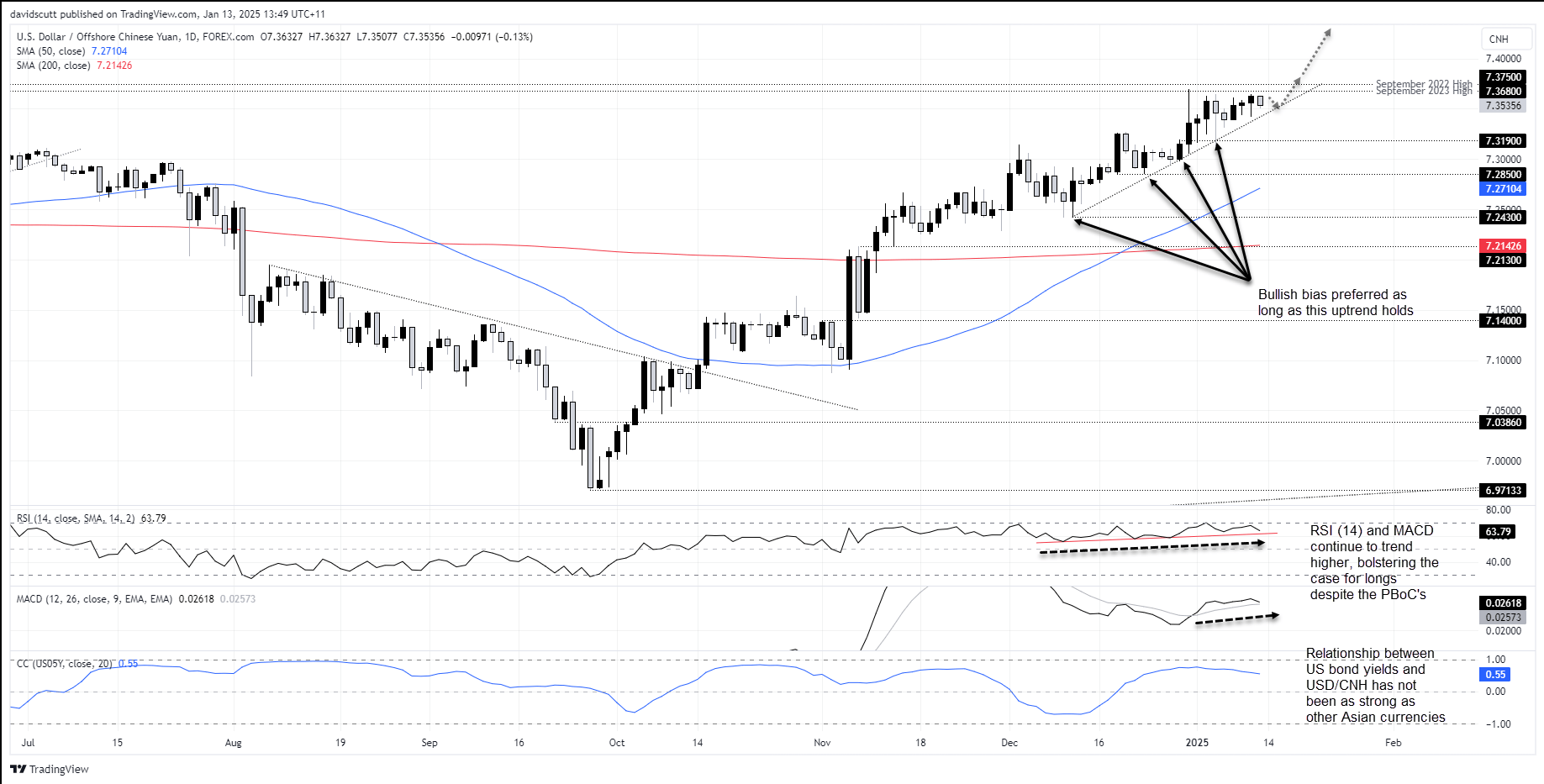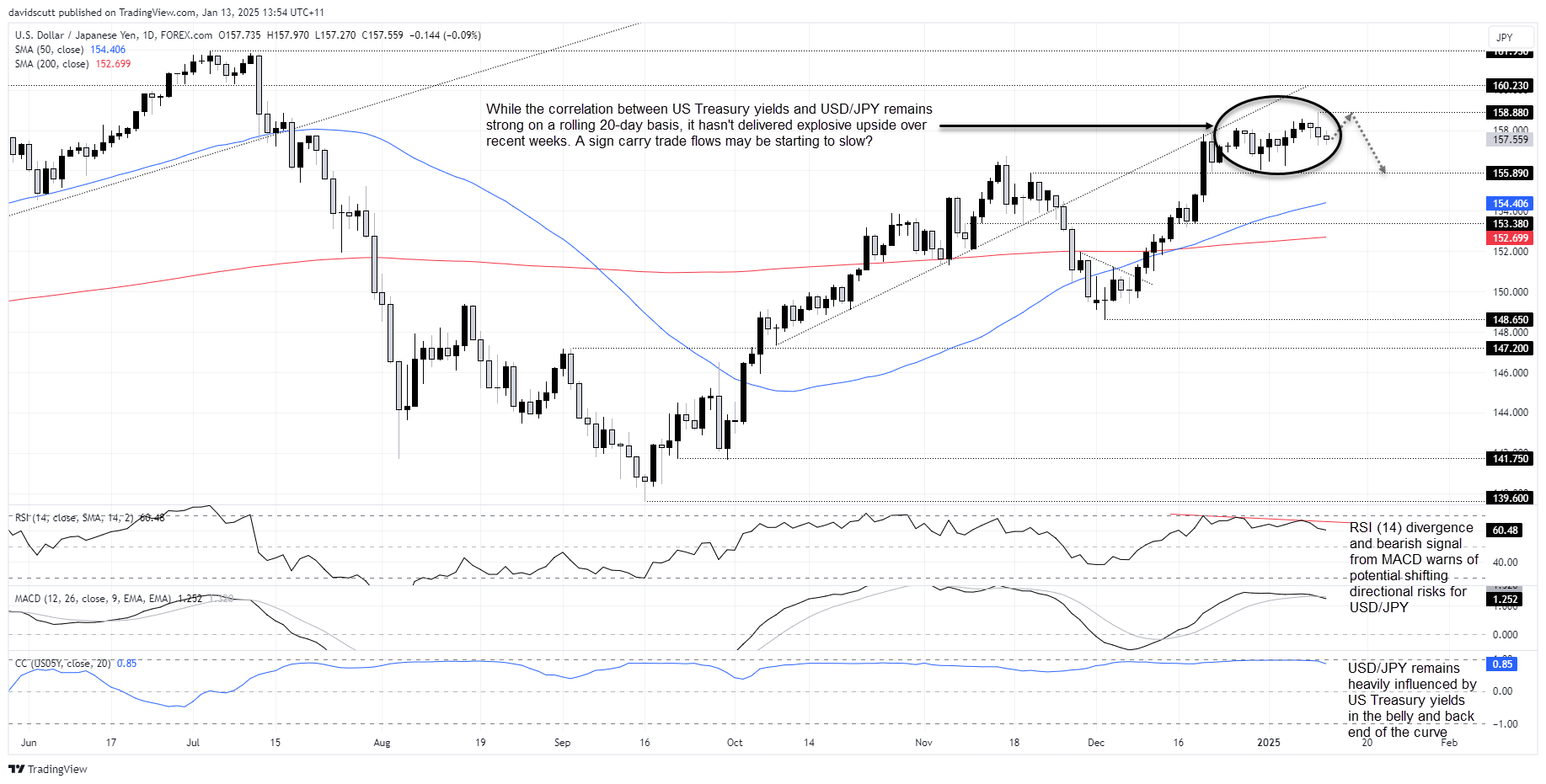USD/CNH: Can PBoC Tweak Tame the Rising Dollar Ahead of US Inflation Data?
2025.01.13 02:59
- PBoC increases cross-border macroprudential adjustment parameter
- Move may encourage capital inflows, supporting Chinese yuan
- USD/CNH bulls eye record high set in September 2022
- USD/JPY bullish momentum showing signs of fatigue
Summary
China’s central bank has moved to support to the beleaguered , delivering a policy tweak that effectively allows Chinese entities to borrow more from overseas markets, potentially encouraging capital inflows.
While the decision has provided a modest boost to the yuan and other currencies like the Japanese yen on Monday, near-term directional risks will likely depend on several key events this week. Without a significant undershoot in US data on Wednesday or a substantial upside surprise in China’s economic data on Friday, the trajectory of USD/CNH may hinge on whether Donald Trump follows through with his tariff threats when he is inaugurated next week.
PBoC Moves to Support Yuan
The State Administration of Foreign Exchange (SAFE), a department within the People’s Bank of China (PBoC), announced Monday that its cross-border macroprudential adjustment parameter would increase from 1.5 to 1.75, effective immediately. For those unfamiliar, this parameter influences the amount of foreign debt Chinese entities are permitted to hold. By raising it, the PBoC has effectively expanded the borrowing capacity of Chinese banks, corporations, and financial institutions in overseas markets, potentially encouraging capital inflows into the country.
The move may curb near-term strength which has been driven by relative growth dynamics and geopolitical risks. However, it is unlikely to deliver a meaningful reversal of the recent trend that has pushed toward the record highs set in September 2022. Similar to other measures such as short-dated offshore yuan bill auctions and strong fixes, this tweak appears more focused on slowing the yuan’s depreciation rather than reversing it altogether.
PBoC officials, like the rest of the market, are likely waiting to see if Trump’s campaign promise to impose tariffs on US imports materialises. Should this occur, the offshore yuan could weaken significantly, driving USD/CNH to fresh record highs. Such a scenario may prompt the PBoC to counteract the impact of tariffs through further currency adjustments.
For now, however, the policy tweak has had its intended effect, with USD/CNH easing slightly in Asian trade on Monday, providing a lift to other Asian currencies, including the Japanese yen.
USD/CNH Bulls Remain in Control
USD/CNH remains in an uptrend on the daily chart, largely reflecting the impact of higher US bond yields and looming Trump tariff threat. However, despite fundamental challenges, it’s not been as impacted other Asian and emerging market currencies during the latest bout of US dollar strength, maintaining only a moderately positive correlation with Treasury yields in the belly of the US interest rate curve. At 0.55 over the past month, it sits significantly below that of other Asian currencies, likely reflecting the impact of PBoC measures to support the yuan.
However, having bounced off uptrend support on multiple occasions since early December, and with RSI (14) and MACD also trending higher, the risk of a topside break looks to be growing despite the PBoC’s efforts.
Source: TradingView
Those considering longs have several options available to them.
One is to buy around these levels targeting a break above the September 2022 high of 7.375, allowing for a stop to be placed beneath the uptrend for protection.
Another would be to wait for another retest of the uptrend, providing the opportunity to establish longs should it continue to hold. This would help improve the risk-reward of the setup relative to the first option.
A third option would be to see if USD/CNH can take out the September 2022 high, providing a setup where longs could be established on the break with a stop beneath for protection. The preference would be to wait for an obvious topping signal if the break were to extend, rather than nominate a specific target for the trade.
If USD/CNH were to break uptrend support the bullish bias would be invalidated, opening the door for potential setups looking for downside.
USD/JPY Reversal Risks Rising?
Source: TradingView
In contrast to USD/CNH, directional risks for appear far more balanced near-term despite the price hitting the highest level since July 2024 following the blowout US nonfarm payrolls report on Friday.
RSI (14) has diverged from price since late December, trending lower as the latter pushed higher. MACD has also crossed over from above, generating a near-term bearish signal. Combined, it suggests momentum may be in the early stages of turning lower, adding to reversal risks for price.
Given the strong positive correlation USD/JPY has seen with five-year Treasury yields over the past month, reversal risks would likely amplify if the US interest rate outlook shifts more dovish.
With dips below 157 bought over the calendar turn, the risk-reward of going short around these levels does not screen as compelling, suggesting those considering shorts may want to wait for a potential retest of Friday’s high of 158.88 before initiating trades.
If the price were to be rejected again at this level, it would generate a decent setup, allowing for shorts to be established below with a tight stop above for protection. 155.89 would be a potential target.
Original Post








